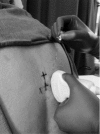The Challenges of Ultrasound-guided Thoracic Paravertebral Blocks in Rib Fracture Patients
- PMID: 32292684
- PMCID: PMC7153808
- DOI: 10.7759/cureus.7626
The Challenges of Ultrasound-guided Thoracic Paravertebral Blocks in Rib Fracture Patients
Abstract
Thoracic paravertebral blocks (TPVBs) provide an effective pain relief modality in conditions where thoracic epidurals are contraindicated. Historically, TPVBs were placed relying solely on the landmark-based technique, but the availability of ultrasound imaging makes it a valuable and practical tool during the placement of these blocks. TPVBs also provide numerous advantages over thoracic epidurals, namely, minimal hypotension, absence of urinary retention, lack of motor weakness, and remote risk of an epidural hematoma. Utilization of both landmark-based and ultrasound-guided techniques may increase the successful placement of a TPVB. This article reviews relevant sonoanatomy as it pertains to TPVBs. However, certain patient-related issues, including pneumothoraces, surgical emphysema, body habitus, and transverse process fractures, all may make imaging with ultrasound challenging. The changes noted on ultrasound imaging as a result of these issues will be further described in this review.
Keywords: chest trauma; nerve block; rib fractures; thoracic paraverterbral block; ultrasound.
Copyright © 2020, Wardhan et al.
Conflict of interest statement
The authors have declared that no competing interests exist.
Figures






References
-
- Practice management guidelines for geriatric trauma: the EAST Practice Management Guidelines Work Group. Jacobs DG, Plaisier BR, Barie PS, et al. J Trauma. 2003;54:391–416. - PubMed
-
- Evidence-based medicine: ultrasound guidance for truncal blocks. Abrahams MS, Horn JL, Noles LM, Aziz MF. Reg Anesth Pain Med. 2010;35:0–42. - PubMed
-
- Ultrasound-guided paravertebral block using an intercostal approach. Ben-Ari A, Moreno M, Chelly JE, Bigeleisen PE. Anesth Analg. 2009;109:1691–1694. - PubMed
-
- Ultrasound-guided intercostal approach to thoracic paravertebral block. Shibata Y, Nishiwaki K. Anesth Analg. 2009;109:996–997. - PubMed
-
- Ultrasonographic diagnosis of suspected hemopneumothorax in trauma patients. Ojaghi Haghighi SH, Adimi I, Shams Vahdati S, Sarkhoshi Khiavi R. https://www.ncbi.nlm.nih.gov/pmc/articles/PMC4310159/ Trauma Mon. 2014;19:0. - PMC - PubMed
Publication types
LinkOut - more resources
Full Text Sources
